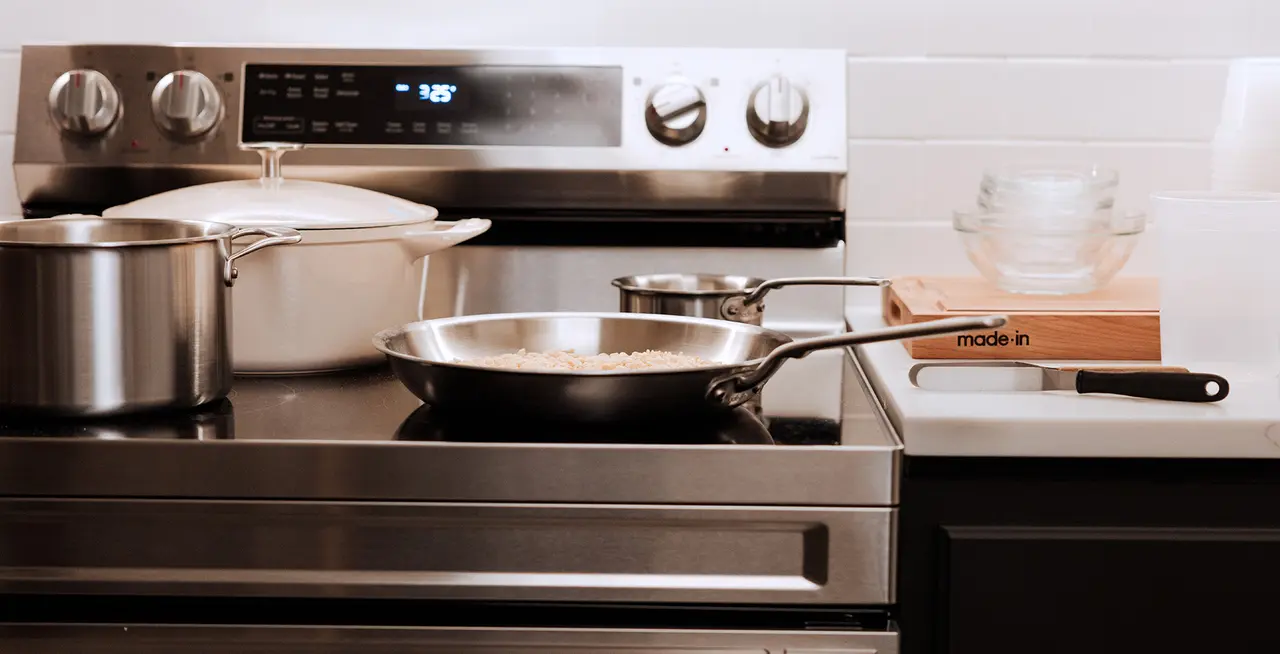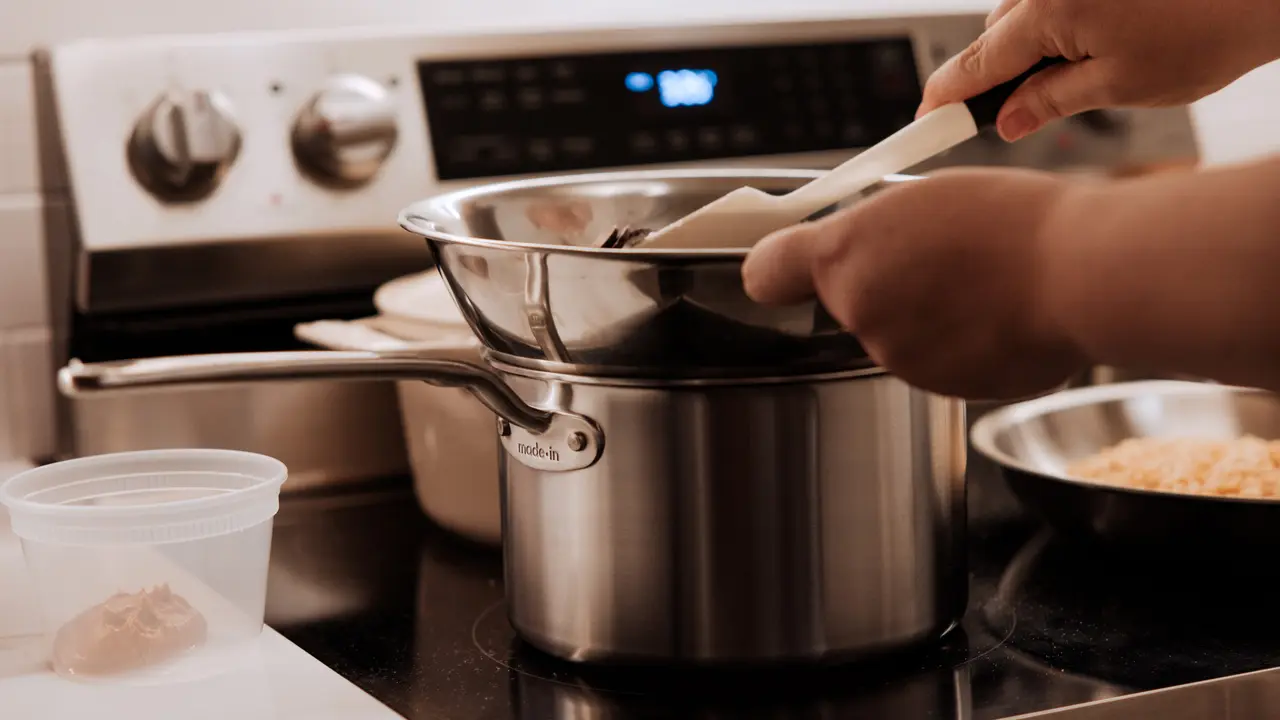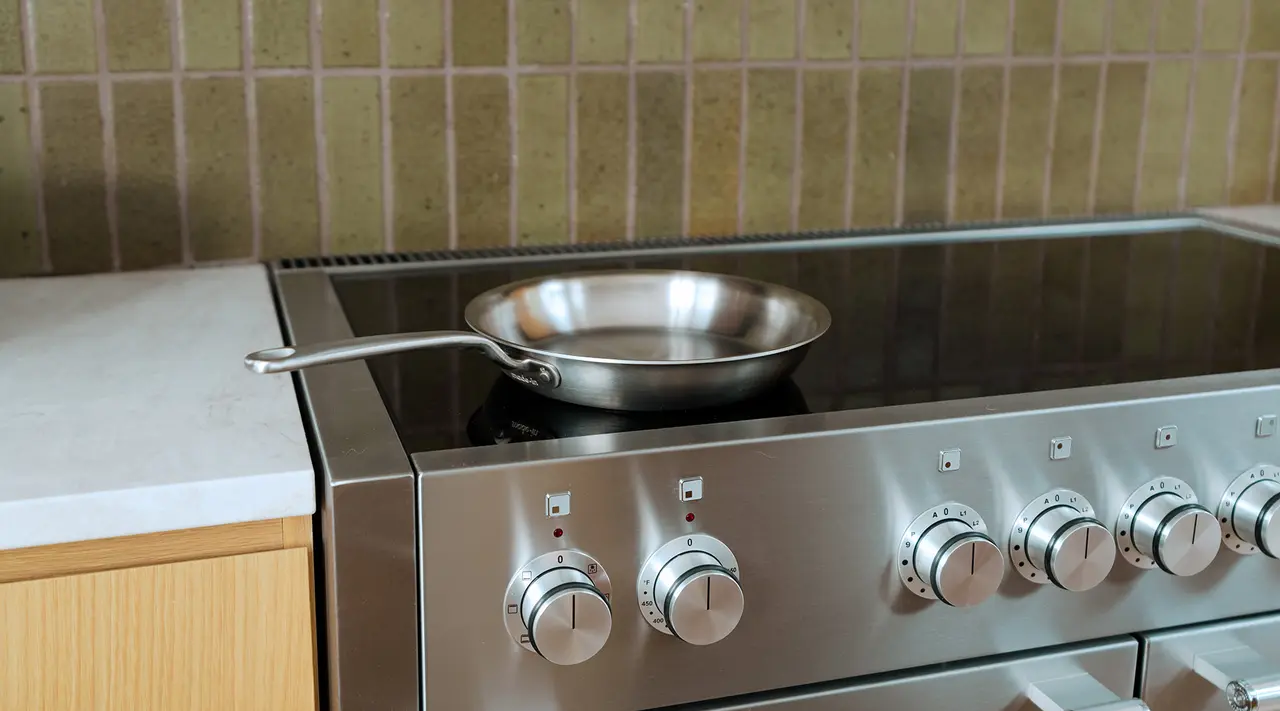Whether you’re planning to install a new glass top induction or electric stove in your kitchen or you’ve been a faithful owner of a glass stovetop for years, it’s a good idea to assess your cookware options.
While you likely don’t need to rush out and rehaul your entire kitchen collection (many common cookware varieties are technically compatible with electric or induction stovetops, the two most common types of glass stoves) there are a few you’ll want to avoid—or at least be extra careful with. Here’s how to know if your existing cookware is glass stove-friendly, and how to shop for new pieces.
What to Look for in Cookware for Glass Top Stoves

The best cookware for glass stoves is lightweight, flat-bottomed, and made of an untextured material to prevent scratching and potential breakage.
Best Materials
- Stainless Steel: Lightweight, induction compatible, and an excellent heat conductor when cladded with materials like aluminum.
- Aluminum: Lightweight and induction compatible, though not as effective at distributing heat as stainless steel cladded with aluminum.
- Copper: Lightweight and responsive, though not induction compatible.
- Titanium: Coating-free non stick option that works on both induction and electric stoves.
Build Considerations
A pot or pan needs to have a totally flat, smooth bottom in order to safely use it on a glass stove—plus, a flat bottom is necessary to produce an electromagnetic field on induction stoves. This eliminates round-bottomed woks and any pieces with ridged or uneven bottoms, which can scratch the glass.
It’s also important to note that lightweight options—like stainless steel, copper, or aluminum—are less likely to damage glass stoves than heavier options like cast iron. And, of course, if your glass-top stove is an induction stovetop, it’s important to make sure your cookware is induction compatible.
Best Cookware Options for Glass Top Stoves

Looking for suggestions? Check out some of our favorite glass stove-friendly options.
Most Versatile: Stainless Clad Frying Pan
Stainless Clad is one of our all-around favorite materials for everything from searing to stir-frying to oven-roasting. It’s also a great, lightweight option for cooking on glass stoves, featuring a smooth, flat base.
Our 5-ply Stainless Clad Frying Pan is incredibly responsive and compatible with all stove types, allowing you to take full advantage of induction’s quick, efficient heating ability.
Easiest Cleanup: Non Stick Frying Pan
Our Non Stick Frying Pan is made from the same lightweight Stainless Clad base as our Stainless Clad Frying Pan, making it an equally solid option for glass stoves. This pan is great for cooking items that might stick to an uncoated frying pan, like eggs and fish, as well as for sautéing vegetables and proteins over low or moderate heat. It also offers superior heat retention and circulation compared to other non stick options, and it’s compatible with all stove tops—including induction.
Most Luxurious: Copper Skillet
Out of all the cookware materials, copper is arguably the most responsive: it can heat up or cool down in seconds, making it ideal for delicate recipes like jam and sugar work. Our luxe Copper Frying Pan is lined with durable, non-reactive stainless steel, and is lightweight enough to safely use on glass stoves. Unfortunately, however, since copper is not an electromagnetic material, it’s not compatible with induction stoves—but can be used on glass-top electric stoves.
Cookware Materials to Avoid
Some materials you should avoid—or at least take extra caution with—when cooking on glass include cast iron, carbon steel, and anything extremely heavy or rough-textured. Cast iron can be fine, but take care when placing it onto the stove or moving it (especially with a Dutch oven) to avoid scratches or cracks.
The same goes for carbon steel, which is compatible for all your high-heat cooking needs, but can also cause damage if you’re not careful with it.
Maintenance and Care Tips

Rusty pan bottoms—or pan bottoms crusted over with layers of burnt-on food—can scratch up your glass stove over time. Giving your pan a good scrub (with or without soap and water, depending on whether your pan is seasoned or not) after each use can keep your stovetop—and your cookware—looking flawless.
It’s also a good idea to store cookware somewhere other than on the stove, especially if it’s made from a heavy or scratchy material like cast iron.
Common Mistakes to Avoid

Here are some tips to help you get the most out of your induction or electric stovetop.
Using the Wrong Material
As we discussed earlier, very heavy cookware—or cookware with a rough or textured bottom—can really do a number on your glass stove. Use an abundance of caution when cooking with carbon steel and cast iron, and never use cookware made from glass or stoneware.
Placing Hot Cookware on a Cold Stove
Placing a super hot pot or pan on a cold glass stove (or vice versa) is a recipe for thermal shock—which can spell disaster for your cookware and stovetop . Make sure to bring your pan to at least room temperature before placing it on the burner.
Ignoring Manufacturer’s Instructions
Always check the manufacturer notes before purchasing an item of cookware—especially if you have an induction stovetop. While non-induction compatible cookware won’t necessarily hurt your induction stove, you’d still be spending money on something that is effectively useless.
Ready to Shop?
Glass top induction and electric stoves are not only healthier, more energy-efficient, and more environmentally friendly than gas stoves, but they can also be a pleasure to cook with. Choosing the right cookware can help you get the most out of your cooking experience, as well as preserve your stove’s pristine surface for years to come.

































